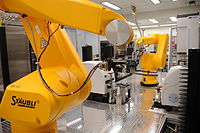
Photo from wikipedia
Enthusiasm surrounding nickel/photoredox C(sp2)-C(sp3) cross-couplings is very high; however, these methods are sometimes challenged by complex drug-like substrates in discovery chemistry. In our hands this has been especially true of… Click to show full abstract
Enthusiasm surrounding nickel/photoredox C(sp2)-C(sp3) cross-couplings is very high; however, these methods are sometimes challenged by complex drug-like substrates in discovery chemistry. In our hands this has been especially true of the decarboxylative coupling, which has lagged behind other photoredox couplings in internal adoption and success. Herein, the development of a photoredox high-throughput experimentation platform to optimize challenging C(sp2)-C(sp3) decarboxylative couplings is described. Chemical-coated glass beads (ChemBeads) and a novel parallel bead dispenser are used to expedite the high-throughput experimentation process and identify improved coupling conditions. In this report, photoredox high-throughput experimentation is utilized to dramatically improve low-yielding decarboxylative C(sp2)-C(sp3) couplings, and libraries, using conditions not previously identified in the literature.
Journal Title: ACS medicinal chemistry letters
Year Published: 2023
Link to full text (if available)
Share on Social Media: Sign Up to like & get
recommendations!